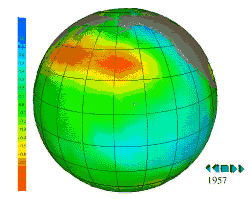Why and how do scientists study climate change in the Arctic? What are the Arctic climate indices?
Some important research concepts used by scientists to study climate change
Nick Bond,
Jim Overland and Nancy Soreide
NOAA / Pacific
Marine Environmental Laboratory
Why is the Arctic important?
Dramatic changes have been occurring in the Arctic during the past decade. These changes include unusual melting of glaciers, sea ice, and permafrost, and shifts in patterns of rain and snow fall, freshwater runoff, and forest/tundra growth. The consequences include disrupted wildlife migration patterns, altered fish stocks, modified agricultural zones, and increased forest fires. These changes have impacted the lives of Native residents who depend on the environment for a continuation of their traditional subsistence lifestyle, and may also have significant impacts on the oil industry, tourism, and shipping routes. The US Arctic Research Commission (1999) stated "change in the Arctic may play a substantial role in climate change throughout the globe", and moreover, that "global change, particularly climate change may have its most pronounced effects in the Arctic." Conditions in the Arctic are very different from those at lower latitudes on the globe, and "the Arctic remains one of the least explored, studied and understood places on earth."
What is climate?
Climate is the long-term average weather. The typical weather (e.g., temperature, rain and snowfall, wind) on any given day tends to be most controlled by the cycle of the seasons from Spring through Summer, Autumn and Winter. Other factors, with longer time scales, can cause systematic changes to the climate. Increasing attention is being devoted to understanding and predicting these factors. A notable example is El Niño. While El Niño involves only the tropical Pacific directly, it has a substantial impact over much of the globe, and consideration of El Niño/La Niña is an important tool for seasonal forecasts. Additional, longer time-scale climate mechanisms, associated with Arctic climate change have been identified and also have impacts around the world. Scientists studying climate change must consider all of the many factors that affect the conditions we experience every day. These interactions are complicated, and scientists try to understand them by using a framework based on climate indices.
What are some climate mechanisms and oscillations?
|
|
References |
|
|
The most familiar climate mechanism or oscillation is the changing seasons, which vary more or less regularly every year from warm summer to cool winter. The next most familiar climate oscillation is probably El Niño, whose intensity is indexed by the Southern Oscillation Index (SOI), which is the difference in air pressure between Tahiti and Darwin, Australia. This index is easy to measure accurately, we have historical records of it, and it is an indicator of the starting time and strength of an El Niño, which occurs irregularly every two to seven years.
Several important climate mechanisms contribute to events occurring at high latitudes and have impacts throughout the globe. These mechanisms have longer time scales than the seasons or the El Niño-Southern Oscillation, which means that they do not occur as frequently (every ten to thirty years). Examples are the Pacific Decadal Oscillation and the Arctic Oscillation, whose consequences include phenomena such as increases or decreases in the severity of winter weather, frequency or severity of winter storms, volume of river runoff, and stocks of various important fishes.
What are the time scales associated with climate mechanisms and modes?
The different modes or mechanisms of the climate system act on different time scales. Some of these mechanisms occur on short time scales, such as the changing of the seasons, which occurs regularly every year, or the El Niño-Southern Oscillation, which occurs irregularly every two to seven years. Others, such as the Arctic Oscillation and the Pacific Decadal Oscillation, are important on time scales of ten to forty years. Variations of thousands of years are associated with orbital cycles of the planet, which appear to be related to past ice ages. The different frequencies of these variations harmonize, in a manner of speaking, to bring about the symphony that is our climate.
It can be difficult to determine exactly when a climate cycle is changing. For example, although everyone is familiar with seasonal variations (spring warming, the hot days of summer, the cooling in autumn and the colder weather in winter), it is difficult to say exactly which day a season begins. Although we have designated June 21, the solstice, as the first day of summer, the warming typical of summer occurs slowly, over some period of time, and warm summer-like days may occur as early as April, or as late as July. It is not so easy to say that summer weather has started on any specific day, or exactly how many days any given summer lasted. This holds true for other climate cycles as well.
Many factors affect the conditions we experience every day. As we have seen, these include the familiar day-to-day weather and the changing seasons, but they also include mechanisms with longer time scales, such as El Niño, and the longer time-scale climate mechanisms have been identified as indices and associated with Arctic climate change.
What are climate indices?
Scientists use climate indices in their attempt to characterize and understand the various climate mechanisms that culminate in our daily weather. Much in the way the Dow Jones Industrial Average, which is based on the stock prices of 30 companies, is used to represent the fluctuations in the stock market as a whole, climate indices are used to represent the essential elements of climate. Climate indices are generally identified or devised with the twin objectives of simplicity and completeness, and each typically represents the status and timing of the climate factor they represent. By their very nature, indices are simple, and combine many details into an generalized, overall description of the atmosphere or ocean which can be used to characterize the factors which impact the global climate system. Because the climate indices are generally determined from measurements made in a localized area, they can have impacts in other areas around the globe, through processes sometimes called teleconnections.
What are some Arctic Climate Indices?
A variety of separate modes seem to be responsible for fluctuations in the Arctic climate. These modes, as summarized through their individual indices, generally vary on decadal time scales. This presents a problem, because it means that we have not experienced enough cycles during the period of reliable observations, which goes back roughly 50 to 100 years, to fully understand their causes and effects. Nevertheless, we have accumulated enough evidence to indicate that variations in these modes are accompanied by systematic changes in the weather, with wide-ranging ramifications. The most important of the Arctic modes, at least as identified to date, are summarized below.
The Arctic Oscillation (AO) and the North Atlantic Oscillation (NAO)
 |
| NAO graphic from Lamont-Doherty Earth Observatory |
The Arctic Oscillation (AO) appears to be the cause for much of the recent changes that have occurred in the Arctic. Its effects are not restricted just to the Arctic; it also represents an important source of variability for the Northern Hemisphere as a whole. The AO has been described as "a seesaw pattern in which atmospheric pressure at polar and middle latitudes fluctuates between positive and negative phases. The negative phase brings higher-than-normal pressure over the polar region and lower-than-normal pressure at about 45 degrees north latitude. The positive phase brings the opposite conditions, steering ocean storms farther north and bringing wetter weather to Alaska, Scotland and Scandinavia and drier conditions to areas such as California, Spain and the Middle East."(University of Washington)
The AO appears related to a well-known mode of variability for the North Atlantic called the North Atlantic Oscillation (NAO). The NAO has been recognized for decades and has been considered "the dominant mode of winter climate variability in the North Atlantic region ranging from central North America to Europe and much into Northern Asia. The NAO is a large scale see-saw in atmospheric mass between the subtropical high and the polar low. The corresponding index varies from year to year, but also exhibits a tendency to remain in one phase for intervals lasting several years." The positive phase of the NAO is associated with more frequent and intense storms in the North Atlantic Ocean, warmer and wetter winters in Europe, and cooler, drier winters in Greenland and northern Canada.
Some controversy exists concerning the relationship between the AO and the NAO, namely whether they represent fundamentally the same mode, or whether the distinctions between them are meaningful. At any rate, a systematically positive sense to both indices since the end of the 1980s has coincided with relatively warm conditions in the Arctic and net melting of the Arctic ice pack.
The Pacific Decadal Oscillation (PDO) and the North Pacific Index (NPI)
 |
| Pacific Decadal Oscillation, shown in the cool phase (cool temperatures along western North America). Click image to animate. |
The Pacific side of the Arctic is also significantly influenced by an inter-related pair of modes, the Pacific Decadal Oscillation (PDO) and the North Pacific Index (NPI). The PDO is based on the pattern of SST in the North Pacific while the NPI is based on sea level pressure. The positive phase of the PDO is associated with warm ocean temperature along western North America and with generally prosperous fisheries in Alaska and poor fisheries along the west coast of the continental US, especially with regards to salmon. The North Pacific Index provides a measure of the intensity of the mean wintertime Aleutian Low pressure cell. An alternative measure of the latter is provided by the Aleutian Low Pressure Index (ALPI).
The PDO is strongly correlated to the NPI/ALPI through air-sea interactions in the North Pacific. The effects of abnormal atmospheric conditions over the North Pacific affect both the currents and temperature of the ocean, which in turn, may feedback on the atmosphere. The ultimate result of variations in these modes is tangible effects on wintertime conditions in the Bering Sea, Alaska and western Canada. A notable shift in these modes occurred in the late 1970s, bringing about a rapid change from relatively cold winters in western North America in the early 1970s to relatively warm, benign winters in the late 1970s and 1980s. There is evidence, based on sea surface temperature, that the PDO changed to a negative or neutral phase in the late 1990s, bringing colder coastal waters once again to the U.S. North Pacific coast.
Summary
Climate mechanisms in the Northern Hemisphere and the Arctic are very active research topics, and our understanding of their causes and effects is far from complete. The importance of this wide-ranging research activity is very well stated by Dr. Nate Mantua, a researcher at the University of Washington, as he speaks about the PDO: "Even in the absence of a theoretical understanding, PDO climate information improves season-to-season and year-to-year climate forecasts for North America because of its strong tendency for multi-season and multi-year persistence. From a societal impacts perspective, recognition of PDO is important because it shows that 'normal' climate conditions can vary over time periods comparable to the length of a human's lifetime."
References
The AO (JISAO
at the University of Washington)
The NAO (Lamont)
NCEP
teleconnections page
PDO (University of Washington)
Compare
PDO/ENSO (University of Washington)
SOI
graph (National Center for Atmospheric Research)
The
Arctic Ocean Response to the North Atlantic Oscillation (AMS)
Pacific
Decadal Oscillation (NASA)
Climate Change
Indicators (Taiga Net)
Bering Sea Climate and
Ecosystem




